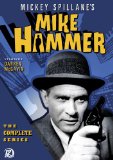“New York City 1958: In these concrete canyons, everybody’s got an angle. The beauty with the sob story who killed her old man. The harmless geezer who’s in bed with the mob. The kidnapped broad who’s really a fraud. When a case gets too twisted for the cops, only one man can straighten it out: two-fisted gumshoe Mike Hammer.”
My earliest memories of Darren McGavin are the tough reporter that stumbled upon supernatural creatures in Kolchak: The Night Stalker. That short-lived series had a huge impact on the likes of Chris Carter and would inspire shows like The X-Files and Supernatural. But Darren McGavin was already a steady veteran of television screens long before his Chicago reporter staked his first vampire. He first came into American living rooms in the 1950’s as Mickey Spillane’s fast-talking film noir detective Mike Hammer. As Mike Hammer he would influence another entirely different genre of television shows. There would be no James Rockford or Magnum PI without him. The character would reappear decades later with Stacey Keach in the title role, but if you want to know what makes the classic television detective tick, you have to go back to the source. A&E just made that possible, and you won’t need a Delorean equipped with the optional flux capacitor to do it.
Hammer (McGavin) was a tough-as-they-come detective. He didn’t fall for the usual cons, and he had street smarts. If he had a weakness at all it was for the “chickies”, the dames, the women. McGavin couldn’t pass up a pretty face or a compelling sob story. When he was caught out in the cold, it was usually because one of these girls put him there. He was fast with a gun. He didn’t mind throwing a guy out of a ten-story window if it got the job done. When Hammer was on the case it usually meant bodies. There was rarely any bad guy still standing to put in a cell. His best friend was Captain Pat Chambers (Burns) of homicide. He would often lean on his buddy for information. If you’ve ever seen Rockford, you’ll recognize the relationship right off the bat. When I hear their conversations about Hammer wanting a plate run or a fingerprint identified, it sure brings back memories of Jimmy and Becker.
The show was only a half hour, so there isn’t any time for fluff here. The episodes get right to the point and often begin with the action already in stride. It’s no big deal to have Hammer shooting it out with some bad guy in the first frames. Hammer offers up a narration that comes right out of the film noir mold. The voice and inflection will further remind you of Kolchak. It’s my guess that some heard these narrations and decided that was the voice of Kolchak. There’s even a Hammer episode where he’s trying to convince the cops that an elder Jack The Ripper might be in town and responsible for a series of dancer slashings.
The city of New York is heavy in the background, just as the cities always are in the traditional film noir tradition. This movie follows the mold pretty closely and might be the most successful attempt of translating that genre onto television screens. It was also one of the first big shows without a network. It was strictly a syndication series that still managed to find enough viewers to keep it solid for two full seasons. It was also the first extremely violent show on television. There were outrages across the nation. TV Guide called it the worst show ever on television while others touted the excess of sex and violence. Tame by our standards the show didn’t pull any punches…or bullets.
There is an impressive list of guest stars on the series. Angie Dickinson gives one of her first performances as a “dame” who gets murdered in the first episode beginning the cries of excessive violence against the show. You’ll also see wonderful performances by: DeForest Kelley, Lorne Green, Ross Elliott, Ted Knight, Barbara Bain, Robert Vaughn, Grace Whitney, Dick Van Patten, Marion Ross, Nita Talbot.
You get all 78 episodes on 12 discs.
Video
Each episode is presented in its original full frame broadcast aspect ratio. The black and white presentation is not going to win you over for its brilliance. There is plenty of print damage, and the image is far from sharp. There’s a warning on each disc that there are going to be serious imperfections. It was built from the best material available. This is strictly an archive kind of print. But it’s very watchable and not as distracting as you might think. I wouldn’t let the audio or video quality scare you away from adding this set to your collection.
Audio
The Dolby Digital 2.0 track doesn’t do the production justice at all. Dialog is the only thing that really comes through. There is a ton of hiss and plenty of distortion. Again, you have to look at this for its archive value.
Special Features
Nothing
Final Thoughts:
If you’re like me, you’ve never really seen this version of Mike Hammer except through old Mystery Channel reruns and the newer version with Keach. Of course, I’ve heard about these episodes for years and had little hope of ever actually seeing them uncut. When this announcement from A&E crossed my path, I jumped on it so fast I could have set an Olympic record. This was one of those times where this job pays off in Spades. Oops, wrong detective. This may be Grandpa’s television, but you’ll be sold as soon as you watch the first episode. “If Grandpa could only see you now.”




